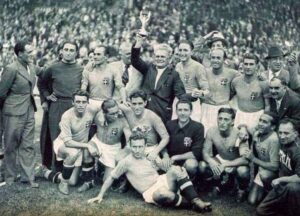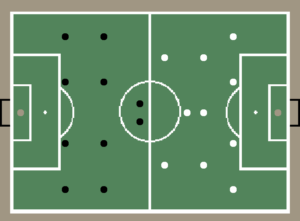Photo by itoldya420.getarchive.net, CC Public Domain Mark 1.0 Universal
A football kit isn’t just a piece of clothing. It’s much more than that. When a player pulls a jersey over his head, he is donning a garment woven with threads of pride, representation and history.
Football kits give clubs and teams an identity and turn collections of individuals into the same sporting unit.
Like the game itself, kits have been wrapped in an evolutionary churn, moving from the stiff, heavy cotton shirts of the 1800s to the cutting-edge designs of today and mirroring football’s progression as a whole.
Indeed, tracing the history of football kits is akin to exploring the sport’s overall journey and the game’s enduring ability to evolve, adapt and inspire.
Humble beginnings: the 1800s
In football’s early days and at the infancy of its organisation during the mid to late 19th century, kits were rudimentary in design, with players often taking to pitches in everyday clothes or the same whites they wore for cricket.
However, as clubs began to form, teams began to use coloured caps and sashes as a form to distinguish themselves, taking some of the first steps towards standardisation.
By the 1870s, distinct team colours began to appear and purpose-made football kits, mostly from heavy cotton or wool, became the norm.
Cotton kits weren’t exactly built for speed, comfort or practicality however, with the long-sleeved and high-collared designs restricting movement. The wetter or muckier the kits were, the heavier they became.
Those cumbersome kits coupled with the era’s primitive boots and thick socks were durable but did nothing to aid athletic performance.
The rise of club identity: early to mid-1900s
The turn of the century was in the rear-view mirror and football’s popularity was on the rise. For the game’s clubs, it was time to establish a more defined identity and kits began to reflect representation.
Though the jerseys remained heavy and slow to dry, more recognisable colour schemes and patterns began to appear in the early 20th century.
Iconic looks, like Glasgow Celtic’s green and white hoops and Arsenal’s red body, white sleeves combo emerged, leading to well-known associations between clubs and their colours.
In the 1950s, numbered football shirts were everywhere, however, by modern standards at least, materials remained relatively primitive, with comfort, flexibility and breathability still sacrificed for simplicity.
Revolution on and off the pitch: 1960s–1980s
Football kits would undergo their first major reimagining in the 1960s and 70s with the development of synthetic fabrics like polyester.
For the first time, traditional wool and cotton-made jerseys were replaced with lighter, sleeker fabrics, marking a major turning point in the history of football kits.
With more athletic cuts and second-skin kits widespread, player performance improved and the speed of the game increased in parallel.
In the 1970s, the first major shirt sponsorships were introduced and though they were controversial at first, they soon became the norm, ushering in a new era of commercial influence in the game and turning football kits into major sources of revenue for clubs.
In 1979, Liverpool became the first English club to have a shirt sponsor when they struck a deal with Japanese company Hitachi, whose logo was emblazed over the Merseysiders’ iconic red jerseys.
The 1980s was a decade of further innovation with bolder designs appearing to compete with the more traditional solid-colour fare of the previous 80 years.
Graphic patterns and prints were now commonplace too – kits were no longer simply sportswear, clubs were beginning to become fashion brands in their own right.
Did You Know❓
— Classic Football Shirts (@classicshirts) February 4, 2022
That Sunderland were the first football team in Europe to wear Nike?
This was the home shirt from 1983-86 featuring the Nike logo on the opposite side. pic.twitter.com/msU7xSvoxG
A fusion of fashion and function: 1990s–2000s
By the time the 1990s hit, football shirts had elbowed their way into mainstream fashion. Replica shirts were in demand and alongside being worn on matchdays by supporters, kits had become casual streetwear and daily staples.
Clubs and kit manufacturers like Umbro, Nike and Adidas fed into the demand by introducing more and more designs, from yearly home and away kits to third kits and other limited edition special releases, with each new shirt accompanied by major marketing campaigns.
Advancements in technology and sports science also started to have major impacts on kit design. From moisture-wicking fabrics and breathable mesh panels to tailor-built and lighter materials, football kits had become cutting-edge performance sportswear.
The modern era: 2010s to today
Since 2010, there has been a further explosion in football kit design and innovation. Today’s jerseys aren’t made, they are engineered, with laser-like scientific precision.
Futuristic materials like Nike’s Dri-FIT and Adidas’s Climacool work as temperature and moisture regulators, while some kits are even manufactured from recycled plastic bottles in a commitment to better environmental sustainability.
From an aesthetic perspective, clubs try to strike a balance between trendiness, functionality and tradition. Every year, kit releases are eagerly anticipated events and launches are accompanied by celebrity photo shoots and big productions.
In addition, bookmakers and online football betting sites have recognised that kits are prime real estate for brand advertising with more jerseys carrying logos from the sports betting industry front and centre than ever before.
Introduced as functional sporting attire on the muddy fields of Victorian England and transformed into the cultural phenomenon of today, the history of football kits has been a compelling side story to football’s own evolution as a sport.




